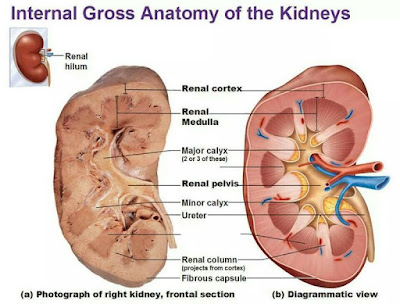Position and function
The kidneys are paired solid organs (11 cm 6 cm 3 cm) usually situated within the retroperitoneum on either side of the spine. They are responsible for:
The kidneys are paired solid organs (11 cm 6 cm 3 cm) usually situated within the retroperitoneum on either side of the spine. They are responsible for:
- urinary excretion
- fluid, electrolyte and acidebase balance
- vitamin D metabolism
- renin and erythropoietin production.
Embryology
Three sets of structures appear and then regress in succession; the pronephros, the mesonephros and the metanephros e which persists to form the definitive kidney. In the male the persistent longitudinal collecting duct of the mesonephros e the mesonephric (or Wolffian) duct forms; the duct of the epididymis, the vas deferens and the ejaculatory duct, the efferent ductules of the testis, the superior and inferior aberrant ductules and the appendix of the epididymis.
The mesonephric duct also gives rise to the ureteric bud in both sexes. Inferiorly this is absorbed into the bladder to become the trigone and part of the urethra, whilst superiorly it forms the ureter, the pelvis of the ureter, the major and minor calyces and the collecting ducts.
The metanephros is initially a pelvic organ, from weeks 6 to 9 of gestation there is progressive development and the kidneys ‘ascend’ the posterior abdominal wall e secondary to the relative growth of the body in the lumbosacral regions and the straightening of its curvature. The ureter elongates as this ‘ascent’ occurs. The ‘ascending’ kidneys receive successive blood supply from lateral splanchnic arteries from the aorta until it reaches its final position opposite L2 vertebrae. Fusion of the lower poles of metanephric tissue results in a horseshoe kidney and alters the ascent and rotation of the developed kidneys. Failure of development or interaction between the ureteric bud and metanephros have been implicated in congenital anomalies such as renal dysplasia and multicystic dysplastic kidneys.
Microscopic anatomy
The outer cortex appears lighter and the inner medulla darker. The medulla is composed of the renal pyramids, each with a rounded apex, which points centrally into the renal sinus where it is cupped by an individual minor calyx (a renal lobe). The renal cortex covers the pyramids peripherally and extends between the pyramids to the renal sinus (the columns of Bertin).
Gross anatomy
The gross anatomy of the kidney is shown in Figure 1. The renal capsule surrounds each kidney; it is a thin fibroelastic structure that encases the meat (parenchyma) and holds sutures whilst the parenchyma is very friable and will not. There is a depression (the hilum) on the medial surface of each kidney, which opens into the renal sinus e a central space surrounded by the renal parenchyma that contains the urinary collecting structures and renal vessels which exit the kidney via the hilum medially and varying amounts of fat. The kidneys are mobile and their position changes during respiration. The right kidney generally lies lower than the left due to the mass of the liver. The upper pole of the left kidney lies at the level of the 12th thoracic vertebrae and its lower pole at the 3rd lumbar vertebrae. The upper pole of the right kidney lies at the level of the 1st lumbar vertebrae and its lower pole at the bottom of the 3rd lumbar vertebrae.
Posteriorly the diaphragm (and the pleural reflection) covers the upper pole/third of each kidney. The 12th rib crosses on both sides at the lower edge of the diaphragm. The upper border of the left kidney extends to the upper border of the 11th rib. Any direct approach to the upper pole of either kidney risks entering the pleural space and this should be minded with all supracostal approaches. The medial portions of the lower two-thirds of both kidneys (with their associated renal vessels and pelvis) lie against the psoas muscle, whilst quadratus lumborum and the aponeurosis of transversus abdominus sit behind both kidneys.






0 comments:
Post a Comment